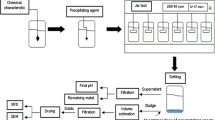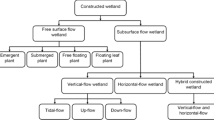Abstract
Mixture of industrial and municipal wastewater causes an increase in concentration of heavy metals in wastewater and sludge. Sludge can be recycled to vermicompost. Heavy metal concentration of resulting vermicompost is important, as they are being used in green spaces, where irrigation disperses heavy metals into the underground water resources and affect the quality of underground water. We study concentration of iron and lead in substrate and worm tissues over time and depth in batch reactors. Two bins of 40 × 40 × 120 cm3 (length × width × depth) are built and filled with sludge (T1) and sludge + soil (T2). We put perforated tubes in four sides of bins and a faucet with constant flow of distilled water above each pilot to produce water flow from top to the bottom of reactors. Pilots run in two stages; with and without the presence of earthworms. To study changes in worm tissues, two bins of 30 × 30 × 30 cm3 (length × width × depth) are built, and earthworm is then added. These bins are filled with sludge (T3) and sludge + soil (T4). Obtained results from (T1) and (T2) confirm heavy metal concentration decrease over time, but increase through depth of reactors. Presence of worms in both reactors shows decrease in concentration of heavy metals. Results obtained from (T3) and (T4) indicate reduction in concentration of lead and iron in substrate and bioaccumulation in worm body mass. TOC of substrate was decreased but TKN increased during time. Initial C/N ratio is 22.2 in pilot T3, and it is decreased to 7.4 and final pH is near 7.













Similar content being viewed by others
References
APHA, AWWA, WPCF (2005) Standard methods for the examination of water and wastewater. Washington, DC
Bhattacharya SS, Chattopadhyay GN (2006) Effect of vermicomposting on the transformation of some trace elements in fly ash. Nutr Cycl Agroecosyst 75:223–231
Bremner JM, Mulvaney RG (1982) Methods of soil analysis. In: Page AL, Miller RH, Keeney DR (eds) Nitrogen total. American Society of Agronomy, Madison, pp 575–624
Chanda GK, Bhunia G, Chakraborty SK (2010) Evaluation of nutrient status of different organic wastes along with environmental quality in the different phases of vermicomposting by Perionyx excavatus Perrier. Manag Environ Quality 21(3):368–378
Dickerson GW (2001) Vermicomposting Guide H-164. Cooperative Extension Service, College of Agriculture and Home Economics, Las Cruces, New Mexico
Edwards CA, Bater JE (1992) The use of earthworm in environmental management. Soil Biol Biochem 24:1683–1689
Elvira C, Goicoechea M, Sampedro L, Mato S, Nogales R (1996) Bioconversion of solid paper-pulp mill sludge by earthworms. Bioresour Technol 57:173–177
Epstein E (1997) The science of composting. Technomic Publishing, Lancaster, pp 109–113, 126, 129
Ghyasvand S, Alikhani HA, Ardalan MM, Savaghebi GR, Hatami S (2008) Effect of pre-thermocomposting on decrease of cadmium and lead pollution in vermicomposting of municipal solid waste by Eisenia fetida. Am-Eur J Agric Environ Sci 4(5):537–540
Harris GD, Platt WL, Price BC (1990) Vermicomposting in a rural community. Biocycle 31:48–51
Jain K, Singh J (2004) Modulating of fly ash induced genotoxicity in vica faba by vermi-composting. Ecotoxicol Environ Saf 59:89–94
Khwairakpam M, Bhargava R (2009) Bioconversion of filter mud using vermicomposting employing two exotic and one local earthworm species. Bioresour Technol 100:5846–5852
Li L, Xu Z, Wu J, Tian G (2010) Bioaccumulation of heavy metals in the earthworm Eisenia fetida in relation to bioavailable metal concentrations in pig manure. Bioresour Technol 101:3430–3436
Liu J, Xu X, Huang D, Zeng G (2009) Transformation behavior of lead fractions during composting of lead-contaminated waste. Trans Nonferrous Met Soc China 19:1377–1382
Logsdon G (1994) Worldwide progress in vermicomposting. Biocycle 3(510):63–65
Maboeta MS, Rensburg L (2003) Vermicomposting of industrially produced woodchips and sewage sludge utilizing Eisenia fetida. Ecotoxicol Environ Saf 56:265–270
Majumdar D, Patel J, Bhatt N, Desai P (2006) Emission of methane and carbon dioxide and earthworm survival during composting of pharmaceutical sludge and spent mycelia. Bioresour Technol 97:648–658
Reinecke AJ, Viljoen SA, Saayman RJ (1992) The suitability of Eudrilus eugeniae, Perionyx excavates and Eisenia fetida (Oligochaeta) for vermicomposting in Southern Africa in terms of their temperature requirements. Soil Biol Biochem 24:1295–1307
Rostami R, Najafi SH, Nabaee A, Eslami A (2010) Survey of E. foetida population on pH, C/N ratio process rate in vermicompost. J Environ Studies. 35(52):93–98
Senesi N (1989) Composted materials as organic fertilizers. Sci Total Environ 81–82:521–524
Singh RP, Agrawal M (2008) Potential benefits and risks of land application of sewage sludge. Waste Manag 28:347–358
Suthar S (2007) Vermicomposting potential of Perionyx sansibaricus (Perrier) in different waste materials. Bioresour Technol 98:1231–1237
Tchobanoglous G, Theisen H, Vigil SA (1993) Integrated solid waste management: engineering principle and management issue. McGraw Hill, New York
Wong SH, Griffiths DA (1991) Vermicomposting in the management of pig-waste in Hong Kong. World J Microbiol Biotechnol 7:593–595
Wong JWC, Selvam A (2006) Speciation of heavy metals during co-composting of sewage sludge with lime. Chemosphere 63:980–986
Yadav SK, Babu S, Yadav MK, Singh K, Yadav GS, Suresh P (2013) A review of organic farming for sustainable agriculture in Northern India. Int J Agron 2013, Article ID 718145
Acknowledgements
The authors would like to express their great appreciation to Mr. Sepehri, the responsible of Shiraz wastewater treatment plant laboratory for his valuable and constructive suggestions during this research. His willingness to give his time so generously has been very much appreciated.
Author information
Authors and Affiliations
Corresponding author
Rights and permissions
About this article
Cite this article
Kharazmi, M., Mirbagheri, S.A., Omrani, G.A. et al. Investigation of Iron and Lead Changes in Wastewater Treatment Sludge Decomposition Reactor With and Without Worm Existence. Iran J Sci Technol Trans Civ Eng 46, 699–715 (2022). https://doi.org/10.1007/s40996-021-00775-9
Received:
Accepted:
Published:
Issue Date:
DOI: https://doi.org/10.1007/s40996-021-00775-9




